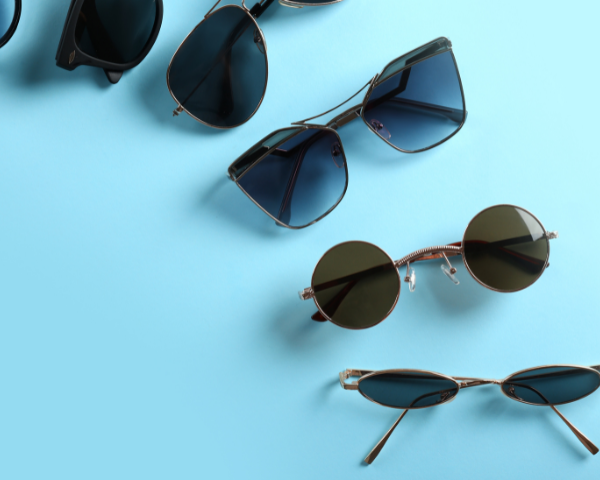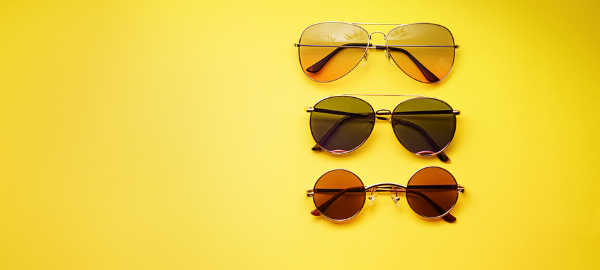The Best UV Protection for Your Eyes

Reviewed by
Beck Jinnette
Have you ever noticed small tags on the lenses of sunglasses when shopping? They indicate the amount of protection the frames provide from harmful UV rays.
If you find yourself confused by terminology such as UV protection, UV400 and the different percentages of UV blockage, don’t panic. We’ll give you all the information required to buy the perfect pair of sunglasses to protect your eyes from these harmful rays.
What are UV rays?
Ultraviolet rays (UV) are radiation emitted by the sun.
The two main types of UV radiation are UVA and UVB rays. UVA rays are more prevalent and can penetrate deeper into the skin, while UVB rays are more intense but don’t penetrate as deep.
On the one hand, exposure to small amounts of UV light is necessary for our bodies to produce vitamin D, which helps strengthen our bones. On the other hand, too much sun exposure can lead to various types of damage to the skin and eyes.
It is essential for people to protect themselves from the harmful effects of UV rays by wearing protective sunscreen and the correct type of sunglasses.
The importance of UV protection
Sunglasses are often viewed as a fashionable accessory, but their essential role in protecting eye health is frequently overlooked. In addition to elevating style, they provide crucial UV protection.
Prolonged exposure to these harmful rays can lead to serious eye damage, as these rays can alter the proteins of the eye lens. Some of these conditions include cataracts and worsening eyesight.
Over time, the damage can become irreversible, causing vision to become blurry, hazy and even less colourful.
While it is common to grab a pair of sunnies on our way out to the beach, quite often, people don’t know that UV rays can reflect off surfaces such as water, snow and buildings on cloudy days.
It is essential to wear sunglasses as often as possible and not only in the summer, as UV rays are not seasonal and cause harm all year long.
Not every pair of sunglasses has UV protection, which means just wearing a generic pair won’t protect your eyes from UV radiation.
Is UV400 the best kind of protection?
UV sunglasses are sunglasses that block UV rays from reaching your eye. There are different percentages of UV protection.
Ideally, it would be best to aim for UV400 sunglasses, as they block out all light rays with wavelengths up to 400 nanometers, as a result, blocking 100% UV rays.
With UV400 protection, you can eliminate UV exposure, making sure your eyes are well-protected and not at risk.
It is important to remember that UV protection is crucial when choosing sunglasses. In fact, dark sunglasses that don’t provide proper protection can cause even greater damage to the eyes: In a dark environment, the pupils are dilated, allowing more UV rays to reach the eyes.
Although you should aim for 100% UV protection, these are the other categories you will find when shopping:

Why UV protection should start early
It is very common for young kids and teenagers not to be aware of how important it is to protect their skin and eyes from the sun. Fortunately, adults tend to be more conscious of the dangers.
That said, UV protection should start early: UV damage is cumulative and the danger grows the more time you spend in sunlight throughout your lifetime.
For this reason, it’s best to start taking precautions and keeping the eyes safe from a young age.

Children are at a higher risk of UV damage because they tend to spend more time outdoors; not only that, but their eyes are also more susceptible to eye damage.
Purchasing a good pair of sunglasses with UV400 protection for your children will help protect their eyes and get them into the habit of protecting them when going out in the sun.
DID YOU KNOW?
The lens of a child’s eye will allow 70% more UV rays to enter the retina than an adult.
UV sunglasses VS polarised lenses
The primary function of polarised sunglasses is to reduce light and glare. These lenses are ideal near water and are even considered the best fishing sunglasses.
Polarised lenses alone, however, do not protect from UV rays. In order to be considered UV protective sunglasses, the polarised lenses must have a UV filter. While not all polarised sunglasses offer UV protection, some can have both.

As previously mentioned, polarised lenses have a different purpose than UV400 protection lenses. This means that just getting a pair of polarised sunglasses won’t provide adequate UV protection for your eyes from the sun’s harmful ultraviolet rays.
Are UV-protective sunglasses expensive?
Fortunately, UV protection glasses come in a wide range of prices.
The range is so wide partially due to different brands having different prices, and partially due to the fact that there are many features that can add to the price.
From polarising and blue light filter lenses to prescription lenses, many factors play into the final cost of the product.
If you’re worried that buying a good pair of sunnies with excellent protection will cost you a fortune, remember there are many affordable options on the market. Protecting your eyes does not have to be expensive.
And if you have any more questions about the effect of UV rays on eye health, feel free to reach out to optical dispensers–they’re here to help
Related articles







































